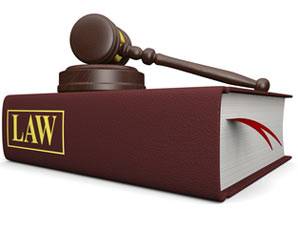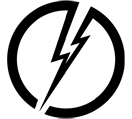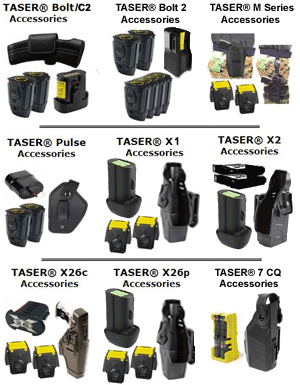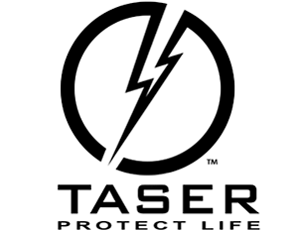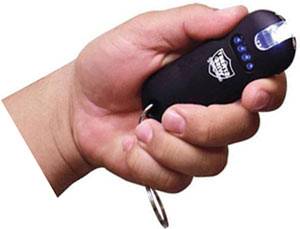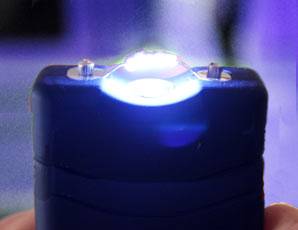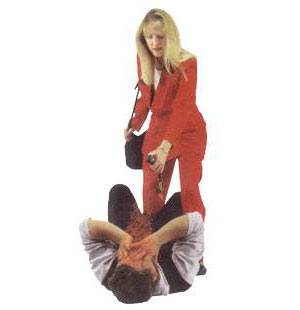Pepper Spray Frequently Asked Questions
|
Purchase Pepper Shot™, Mace® and Wildfire™ pepper spray and tear gas to protect yourself and your family. In addition to causing an attacker pain, self-defense sprays swell the mucous membranes, which makes breathing difficult, and swells the veins in the eyes, causing the eyes to close. These effects last 20-30 minutes and cause no permanent damage. Here you'll find the most commonly asked questions about defense sprays. |
|
|
Purchase pepper spray and tear gas, by Pepper Shot™, Mace® and Wildfire™ to protect yourself and your family. In addition to causing an attacker pain, self-defense sprays swell the mucous membranes, which makes breathing difficult, and swells the veins in the eyes, causing the eyes to close. These effects last 20-30 minutes and cause no permanent damage. Here you'll find the most commonly asked questions about defense sprays.
|
What is Pepper Spray?Pepper Spray is an aerosol spray used for self-defense. Pepper Spray is a defense spray. Pepper spray consists of a concentrated agent injected into a canister and dispersed, or sprayed, by aerosol. The concentrated agent is Oleoresin Capsicum. Oleoresin Capsicum is extracted from chili peppers and is the chemical that gives peppers their hot quality. That is why it is called pepper spray. Also, Oleoresin Capsicum is known as “OC” for short. That is why pepper spray is commonly referred to as OC pepper spray. What is Mace®?Just as many people mistakenly refer to tissue paper as “Kleenex” or refer to a photocopy as a “Xerox,” many people refer to defense sprays as “Mace.” Mace is a brand name that carries a registered trademark owned by Mace® Security International (MSI). MSI originally marketed a particular tear gas self defense spray. Today, Mace® brand defense sprays either contain OC pepper, tear gas or both. What is Tear Gas?There are three major chemicals used as tear gases: 1. CS The first two are CS and CN, short for orthochlorobenzalmalononitrile and chloroacetophenone, respectively. A third, code named CR (dibenz(b,f)-1,4-oxazepin), has not come into civilian use. Both CS and CN tear gas are synthesized chemicals known as lachrymators. A lachrymator is a substance that produces profuse tearing. At standard temperature and pressure, these chemicals are actually white crystals with fairly low vapor pressures, not gasses, and they are not very soluble in water. In order to disperse them, they are suspended in a liquid carrier and aerosolized. Pepper Spray vs. Tear GasPepper spray is not tear gas. Tear gas is not pepper spray. Pepper spray is a defense spray. Tear gas can be used as a defense spray. Two important differences between pepper spray and tear gas are: 1. Tear gas is an irritant, and therefore its effectiveness relies mainly on pain compliance. Pepper spray is an inflammatory agent. The response to contact with pepper spray is involuntary which makes pepper spray a very effective weapon against drug or alcohol impaired assailants or animals that may not respond to pain. As Doug Lamb writes in “Tactical Use of Defense Sprays” - When a person is sprayed with OC pepper spray, two things happen instantly. First, the person’s eyes clamp shut, hard. Not only that, but if that person does manage to force his eyes open, the person still cannot see because the OC dilates the capillaries and causes temporary blindness. Second, an immediate fit of uncontrollable coughing doubles the person over because the OC causes instant inflammation of the breathing tissues, restricting all but life support breathing. An assailant who is sprayed with OC stops what he is doing and stops what he is thinking – period. This is true even for those who are drunk, on drugs, or psychotic. 2. Tear gas has a high level of toxicity. OC pepper spray is totally non-toxic. We Recommend the Booklet “Tactical Use of Defense Sprays”.The "Tactical Use of Defense Sprays", gives pointers on choosing a defense spray, how to carry it, how to shoot it, what to do about multiple assailants, date rape protection, using defense sprays against guns and knives, home tactical use and much, much more about the realities of protecting yourself with defense sprays. Written by nationally recognized self-defense expert Doug Lamb. Are All Pepper Sprays the Same?No, all pepper sprays are not the same. Pepper sprays are rated in two ways: Percentage of Oleoresin Capsicum in the agent itself, and the “hotness” of the spray, which is measured in Scoville Heat Units (SHU’s). The percentage of OC has nothing to do with the SHU rating, and vice versa. One of the biggest misconceptions about pepper spray is that the higher the OC percentage, the hotter and more effective the spray. In most cases, this could not be further from the truth. The best, fastest incapacitating pepper sprays in the world are from 2% to 10% OC. The lighter the fluid, the faster it penetrates the membranes. So, the percentage of OC is important, but even more important is the SHU rating, as the percentage has nothing to do with the actual SHU rating or “hotness” of the spray. The Physical Effects of Pepper SprayPepper Spray has four physiological effects that may be experienced: 1. Eyes – tearing, involuntary closing or complete closing due to dilation of the eye capillaries. Eyes will appear red/bloodshot for 30 to 60 minutes. People wearing eyeglasses or contact lenses will be equally affected. 2. Respiratory System – immediate inflammation, including swelling of the throat lining which can restrict the airway size. Respiratory functions return to normal within 10 to 45 minutes. The airway will be open enough to allow for sufficient oxygen flow for survival. Due to the reduced airway flow, the person will probably not receive enough oxygen to continue fighting or other sustained physical exertion. Temporary paralysis of the larynx. Uncontrollable coughing, retching, and gasping for air with a gagging sensation in the throat. 3. Effect on the skin: inflammation of the exposed skin with a burning sensation. 4. Effects on muscle coordination: pepper spray exposure may cause a person to lose balance due to the effect of pepper spray on vision. How Can I Be Sure My Pepper Spray Will Work When I Need It?You should get in the habit of testing your defense spray every 90 days. To do this first go outside and determine which direction the wind is blowing. Remember to always stand upwind from the direction you are spraying. Depress the firing mechanism for ½ second. This test should be performed upon purchase and every 90 days after that. Be aware that every time you test your spray you reduce the contents of the canister. If you are using a key chain model and you test regularly you will need to replace the unit every couple of years if you follow the recommended testing procedure above. How Long Will My Pepper Spray Last?Most pepper sprays have an expiration date stamped on the canister, usually 2 to 4 years from the time of manufacture. Although the spray life is indefinite, it does start to lose potency over time. Any use of the spray beyond the expiration date is highly inadvisable. We strongly advise you to replace your pepper spray long before the expiration date! That way you are always assured of the potency of the spray. Take your old one to a safe place and target practice with it. Become familiar with how far it will spray, how to unlock it, etc. When practicing with your defensive spray, be aware of air movements and wind patterns and be very careful not to contaminate yourself. How is Pepper Spray Made?Pepper spray is derived from hot peppers. The oils are extracted from the hot peppers using a high-pressure process. This process leaves you with the active ingredient in pepper spray known as Oleoresin Capsicum, or “OC.” OC is a reddish-orange, oily liquid, insoluble in water. The pure pepper extract is then diluted with an inert ingredient that reduces the “hotness” of the extract to get it down to a usable level for pepper spray. The History of Pepper SprayOleoresin capsicum spray was developed at the University of Georgia by Professor James H. Jenkins and Dr. Frank Hayes, D.V.M., in 1960. That formula under the brand name Halt Animal Repellent was first sold in 1963. Like tear gas, oleoresin capsicum (OC) is non-lethal and induces temporary incapacitation with no known long-term effects. In 1989 the Firearms Training Unit (FTU) of the FBI Academy in Quantico, Virginia, completed three years of intensive research on OC, following which the FBI authorized the use of OC for its special agents and SWAT teams. In addition, OC has proven effective against domestic and wild animals without endangering the animals or the environment. OC, in proper dispensing systems, has been successfully used to stop grizzly bear attacks in Alaska and pit bull dog attacks in California and Texas. The US Postal Service also issues OC to its letter carriers and animal control facilities also issue animal repellent to its officers to protect them from dog bites. The History of Scoville Heat Units (SHU’s)Scoville Heat Units (SHU's) is the measurement of the “hotness” of pepper. All types of chili peppers, including green peppers, jalapeños, and habaneros, all contain an unusually powerful compound found in no other plant, an alkaloid called capsaicin. Capsaicin is the horticultural term for the genus that chili peppers are classified. A single drop of tasteless and odorless capsaicin in 100,000 drops of water is very noticeable. In fact, capsaicin can be detected by humans at one part per million. In 1912, pharmacologist Wilbur Scoville developed a standard for measuring the power of capsaicin: the Scoville Organaleptic Test. Scoville measured exact weights of chili peppers and dissolved the capsaicin in alcohol. This solution was then diluted with sugar water until it was no longer detectable to the human palate. A panel of five taste testers would taste the solution and three of them had to agree before a value was assigned. If, for example, it took 1,000 parts of water to one part of capsaicin, it was said to have 1,000 Scoville Heat Units. This method was useful for calculating the temperature of peppers used in many pharmaceutical products such has heat rubs. Today, high-performance liquid chromatography is used to measure the capsaicin content in peppers. It measures capsaicin levels in parts per million which is then converted to Scoville Heat Units (SHU’s). The pepper scale ranges from zero Scoville Heat Units for a bell pepper to 5,000 or so SHU’s for a jalapeño, to a whopping 200,000 to 300,000 SHU’s for a habanero. Pure capsaicin is 15,000,000 SHU’s. |
Reviews

